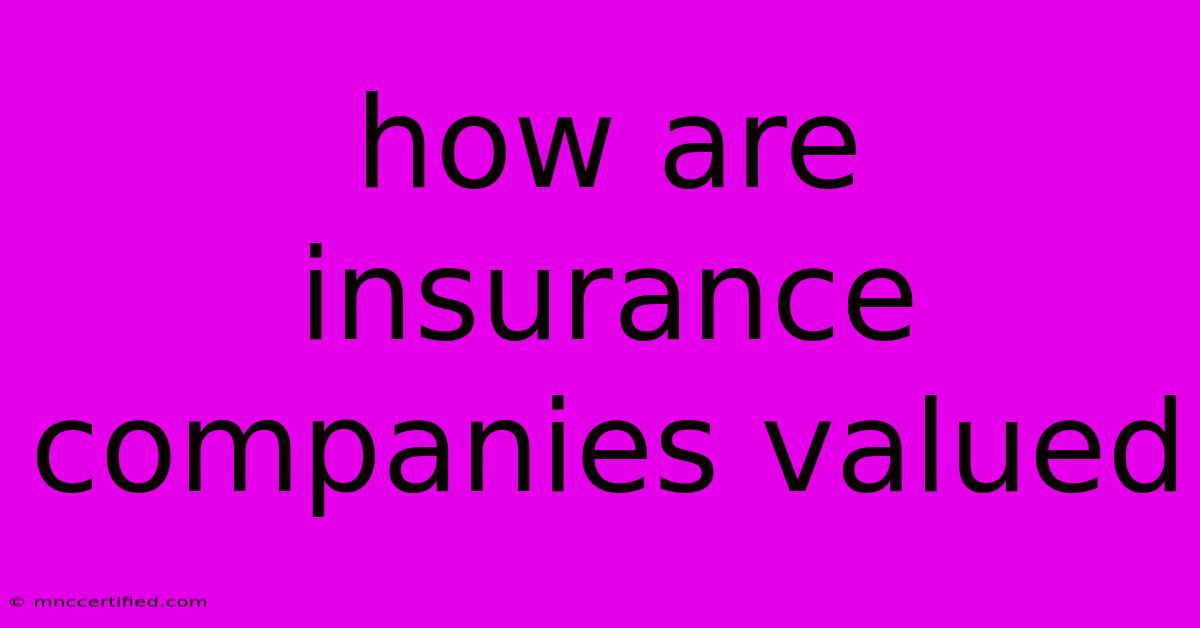How Are Insurance Companies Valued

Table of Contents
How are Insurance Companies Valued? A Comprehensive Guide
Insurance companies, behemoths of the financial world, play a crucial role in managing risk and providing financial security. But how are these complex entities valued? It's not as simple as looking at their assets and subtracting liabilities. The valuation process is multifaceted, incorporating various financial models and considerations specific to the industry. This guide will delve into the key methods used to determine the worth of an insurance company.
Understanding the Unique Challenges of Insurance Valuation
Valuing an insurance company presents unique challenges compared to other industries. Unlike a manufacturing company with tangible assets, a significant portion of an insurer's value lies in intangible assets, such as:
- Underwriting expertise: The ability to accurately assess and price risk is a key driver of profitability and, therefore, value.
- Brand reputation and customer loyalty: Strong brand recognition and a loyal customer base contribute significantly to long-term stability and revenue streams.
- Distribution network: A well-established distribution network, whether through agents, brokers, or online platforms, is critical for reaching customers and generating sales.
- Investment portfolio performance: Insurance companies invest premiums to generate returns, and the performance of their investment portfolios directly impacts their profitability and overall valuation.
These intangible assets are difficult to quantify directly but significantly influence the overall value.
Key Valuation Methods for Insurance Companies
Several methods are employed to value insurance companies, each with its strengths and weaknesses:
1. Discounted Cash Flow (DCF) Analysis
This is arguably the most common and comprehensive method. DCF analysis projects future cash flows generated by the insurance company and discounts them back to their present value using a discount rate that reflects the risk involved. Key factors considered include:
- Projected premium growth: Forecasting future premium income based on market trends, competitive landscape, and the company's growth strategy.
- Loss ratio: Estimating the proportion of premiums paid out as claims. Accurate loss ratio forecasting is crucial for accurate valuation.
- Expense ratio: Projecting the company's operating expenses as a percentage of premiums.
- Investment income: Estimating returns from the investment portfolio, considering market conditions and the company's investment strategy.
- Discount rate: This reflects the risk associated with the future cash flows and incorporates factors like the company's financial leverage and the overall market environment. A higher discount rate results in a lower valuation.
Strengths: DCF analysis provides a detailed, forward-looking view of the company's value. Weaknesses: It relies heavily on projections, which can be inherently uncertain, particularly in the long term.
2. Market Multiples
This method compares the insurance company's valuation metrics (e.g., price-to-book ratio, price-to-earnings ratio) to those of comparable publicly traded companies. This provides a benchmark for valuation. However, finding truly comparable companies can be difficult due to variations in business models, product mix, and risk profiles.
Strengths: Relatively simple and quick to implement. Provides a market-based perspective. Weaknesses: Relies on the availability of comparable companies and may not accurately reflect the unique characteristics of the target company.
3. Asset-Based Valuation
This approach focuses on the net asset value (NAV) of the company, which is the difference between the fair market value of its assets and liabilities. It's particularly relevant for companies with significant tangible assets or those in run-off (no longer writing new business).
Strengths: Simple to understand and relatively easy to calculate. Useful for companies with significant tangible assets. Weaknesses: May undervalue intangible assets and future earning potential. Less relevant for actively operating insurers.
Factors Influencing Insurance Company Valuation
Besides the valuation methods, several external and internal factors influence the final valuation:
- Regulatory environment: Changes in regulations can significantly impact an insurer's profitability and operational costs.
- Economic conditions: Economic downturns can increase claims frequency and severity, impacting profitability.
- Interest rates: Interest rate fluctuations affect the return on investment portfolios and the discount rate used in DCF analysis.
- Competition: Intense competition can pressure premium rates and profitability.
- Catastrophe risk: The potential for large-scale catastrophic events (e.g., hurricanes, earthquakes) can significantly impact an insurer's profitability and solvency.
Conclusion:
Valuing an insurance company is a complex process that requires a deep understanding of the industry, financial modeling techniques, and consideration of both tangible and intangible assets. A combination of the methods described above, along with a thorough analysis of the relevant factors, provides the most comprehensive and accurate valuation. It is essential to engage experienced professionals for a robust and reliable assessment.

Thank you for visiting our website wich cover about How Are Insurance Companies Valued. We hope the information provided has been useful to you. Feel free to contact us if you have any questions or need further assistance. See you next time and dont miss to bookmark.
Featured Posts
-
Complete Coverage Insurance Agency
Nov 17, 2024
-
Embedded Vs Non Embedded Insurance
Nov 17, 2024
-
Moonflower Murders Mystery And Charm
Nov 17, 2024
-
Colorado Vs Utah 2024 Prediction
Nov 17, 2024
-
Kwons Death Cobra Kai Season 6 Analysis
Nov 17, 2024